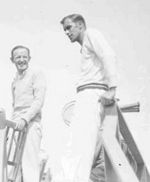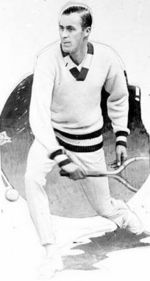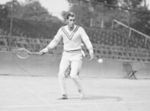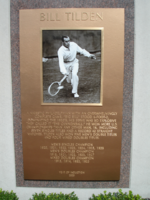Bill Tilden: Difference between revisions
imported>Hayford Peirce (→His troubled personal life: brought in more info from Wikipedia, but did some rewriting) |
imported>Hayford Peirce (moved some info around -- now to fix a formatting problem) |
||
| Line 43: | Line 43: | ||
[[Allison Danzig]], the main tennis writer for ''[[The New York Times]]'' from 1923 through 1968, and the editor of ''The Fireside Book of Tennis'', called Tilden the greatest tennis player he had ever seen. "He could run like a deer," Danzig once told [[CBS Sports]]. An extended Danzig encomium to Tilden's tennis appears in the July 11, 1946 issue of ''The Times'', in which he reports on a 1920's-evoking performance in the first two sets of a five-set loss by the 53-year-old Tilden to [[Wayne Sabin]], at the 1946 Professional Championship at Forest Hills.<ref>{{cite news| url=https://www.nytimes.com/1946/07/11/archives/sabin-rally-halts-tilden-in-five-sets-big-bill-eliminated-from-pro.html | work=The New York Times | title=Sabin Rally Halts Tilden In Five Sets; 'Big Bill' Eliminated From Pro Tennis Tourney | date=July 11, 1946 | accessdate=April 26, 2010 | first=Allison | last=Danzig}}</ref> | [[Allison Danzig]], the main tennis writer for ''[[The New York Times]]'' from 1923 through 1968, and the editor of ''The Fireside Book of Tennis'', called Tilden the greatest tennis player he had ever seen. "He could run like a deer," Danzig once told [[CBS Sports]]. An extended Danzig encomium to Tilden's tennis appears in the July 11, 1946 issue of ''The Times'', in which he reports on a 1920's-evoking performance in the first two sets of a five-set loss by the 53-year-old Tilden to [[Wayne Sabin]], at the 1946 Professional Championship at Forest Hills.<ref>{{cite news| url=https://www.nytimes.com/1946/07/11/archives/sabin-rally-halts-tilden-in-five-sets-big-bill-eliminated-from-pro.html | work=The New York Times | title=Sabin Rally Halts Tilden In Five Sets; 'Big Bill' Eliminated From Pro Tennis Tourney | date=July 11, 1946 | accessdate=April 26, 2010 | first=Allison | last=Danzig}}</ref> | ||
Tilden, who was one of the most famous athletes in the world for many years, today is not widely remembered despite his former renown. During his lifetime, however, he was a flamboyant character who was never out of the public eye, acting in both movies and plays as well as playing tennis. He also had two arrests for sexual misbehavior with teenage boys in the late 1940s; these led to incarcerations in the Los Angeles area. In 1950, in spite of his legal record, which caused him to be shunned by much of the tennis world, an Associated Press poll named | Tilden, who was one of the most famous athletes in the world for many years, today is not widely remembered despite his former renown. During his lifetime, however, he was a flamboyant character who was never out of the public eye, acting in both movies and plays as well as playing tennis. He also had two arrests for sexual misbehavior with teenage boys in the late 1940s; these led to incarcerations in the Los Angeles area. In 1950, in spite of his legal record, which caused him to be shunned by much of the tennis world, an [[Associated Press]] poll named Tilden the greatest tennis player of the half-century by a wider margin than that given to any athlete in any other sport (310 out of 391 votes).<ref name="fischer2009"> | ||
== His troubled personal life == | == His troubled personal life == | ||
| Line 58: | Line 58: | ||
After his second incarceration Tilden was increasingly shunned by the tennis world. He was unable to give lessons at most clubs and even on public courts he had fewer clients. At one point he was invited to play at a prestigious professional tournament being held at the Beverly Wilshire Hotel; at the last moment he was told that he could not participate. Philadelphia's [[Germantown Cricket Club]], his home court, revoked his membership and took down his portrait,<ref>Richard Schickel, p. 77</ref> although it has since been restored.<ref> https://www.nytimes.com/2016/05/01/sports/tennis/bill-tildens-legacy-unsettled-where-jerry-sanduskys-still-looms.html</ref> His criminal record still casts a long shadow: in March, 2016, a proposal to honor him with a historical marker at the club was voted down by the state of Pennsylvania panel charged with evaluating nominations.<ref>{{cite web |url=https://www.yahoo.com/news/bill-tilden-us-tennis-hero-morals-clause-052534374.html?ref=gs |title=Bill Tilden: A US tennis hero, but with a morals clause|author=Associated Press|date=28 April 2016|publisher= Yahoo! News |access-date= 18 May 2016}}</ref> | After his second incarceration Tilden was increasingly shunned by the tennis world. He was unable to give lessons at most clubs and even on public courts he had fewer clients. At one point he was invited to play at a prestigious professional tournament being held at the Beverly Wilshire Hotel; at the last moment he was told that he could not participate. Philadelphia's [[Germantown Cricket Club]], his home court, revoked his membership and took down his portrait,<ref>Richard Schickel, p. 77</ref> although it has since been restored.<ref> https://www.nytimes.com/2016/05/01/sports/tennis/bill-tildens-legacy-unsettled-where-jerry-sanduskys-still-looms.html</ref> His criminal record still casts a long shadow: in March, 2016, a proposal to honor him with a historical marker at the club was voted down by the state of Pennsylvania panel charged with evaluating nominations.<ref>{{cite web |url=https://www.yahoo.com/news/bill-tilden-us-tennis-hero-morals-clause-052534374.html?ref=gs |title=Bill Tilden: A US tennis hero, but with a morals clause|author=Associated Press|date=28 April 2016|publisher= Yahoo! News |access-date= 18 May 2016}}</ref> | ||
== Death == | == Death == | ||
Revision as of 11:59, 20 August 2018
William Tatem Tilden II (February 10, 1893 – June 5, 1953), often called "Big Bill", was a flamboyant American tennis player who was the World No. 1 player for 7 years, the last time when he was 38 years old, and is still a candidate for being the greatest male player of all time. Born in Philadelphia, Pennsylvania, to a wealthy family, he was a "Junior" at birth but changed his name to "II" when he was in his mid-20s. A champion player of the 1920s and 1930s known for both his great skills and his showmanship on and off the court, Tilden was the single most influential person in the history of tennis. He was also perhaps the most paradoxical figure in the history of any sport — a gay man who almost single-handedly changed the image of tennis from that of a "sissy" country-club sport played only by rich white people in long white pants or ankle-length skirts to that of a major sport played by robust, world-class athletes.[1]
In the United States' sports-mad decade of the Roaring Twenties Tilden was one of the five dominant figures of the "Golden Era of Sport", along with Babe Ruth, Red Grange, Bobby Jones, and Jack Dempsey. His subsequent arrests and convictions on charges of soliciting underage males, however, eventually cast a shadow over his illustrious career and he died impoverished. As recently as 2004, more than 50 years after his death, a play about Tilden called Big Bill was produced at the Lincoln Center Theatre in New York.[2]
Greatness as a player
Except for an extended period in the 1950s when Pancho Gonzales completely ruled the men's professional tour, there has never been an era in tennis more dominated by a single player. During a 7-year period in the 1920s it was said that Tilden never lost a single important match, particularly in the Davis Cup matches that in those days had far more importance than they do today. Among his many achievements, he won the United States amateur championship 6 times in succession and 7 times altogether. And from 1920 through 1926 he led the United States team to 7 consecutive Davis Cup victories, a record that is still unequalled.
Tilden was generally considered to be the world's best player for 7 years, second only to Gonzales's 9 No. 1 ratings, tied with Rod Laver but ahead of Jack Kramer, Ken Rosewall, and Pete Sampras, all of whom had 6.

Photo courtesy of the Chicago Historical Society.
Unique among tennis players, Tilden became a great player only at the relatively advanced age of 27. Prior to 1920 he had won a number of national doubles titles but had lost to Lindley Murray and "Little Bill" Johnston in the 1918 and 1919 singles championships. In the winter of 1919-20 he moved to Rhode Island where, on an indoor court, he devoted himself to remodeling his relatively ineffective backhand. It was all he needed. He emerged with a new grip and a powerful new backhand in the summer of 1920 and for the rest of the decade dominated world tennis. Except, perhaps, for Vinnie Richards, Johnston remained the second best American player for the next 6 or 7 years but was never again able to beat Tilden in an important match.
Tall, lean, and gangly, with long arms, enormous hands, and exceptionally broad shoulders, Tilden possessed what was called at the time a "cannonball" service. Although he could serve aces almost at will, he had little interest in advancing to the net behind his serve. He primarily used spin and slice serves, reserving his famous cannonball for crucial moments in the match. In spite of his powerful serve, Tilden preferred to play mostly from the backcourt, where he dazzled opponents with his ever-changing tactics: a mixture of guile, of chopped and sliced shots, of dropshots and lobs, and of sudden powerful ground strokes deep to the corners. He hit superbly angled shots on nearly impossible returns and liked nothing better than to face an opponent who threw powerful serves and ground strokes at him and who rushed the net - one way or another Tilden would find a way to hit the ball past him. An iconic photograph of Tilden shows him leaping high into the air to hit an overhead smash with classic footwork, form, and power. Some contemporaries, however, considered Tilden's overhead to be the single weakness in his game. Some later commentators felt that a 1960s player such as Ken Rosewall would have been able to exploit this weakness by the deft use of offensive lobs.
It was little known at the time, but mid-way through the 1920s the tip of Tilden's middle finger on the hand that gripped the racquet became infected and had to be amputated. He also had a chronic knee problem that hindered him seriously from time to time. This too was concealed from the public and hardly seemed to impede him in his long string of victories.
In 1941, when Bill Tilden was 48 years old, he toured the United States playing head-to-head matches with Don Budge, who at that time was incontestably the best player in the world. One tennis historian, Joe McCauley, writes that Budge defeated Tilden 51-7 in their head-to-head tour; others give slightly different results, but in the whole history of tennis, only Pancho Gonzales and Ken Rosewall have ever approached the sustained level of Tilden's greatness after reaching the age of 40.
Tilden the intellectual
Tilden may have spent more time analyzing the game of tennis than anyone before or since. He wrote three books about the game, The Art of Lawn Tennis (online text), How to Play Better Tennis, and Match Play and the Spin of the Ball, the latter of which is still in print and is the definitive work on the subject. Besides his great physical abilities, he was an extremely cerebral player, a master of both strategy and tactics, adept at adapting himself to his opponent's style and turning his strengths against him. He was also known for his showmanship, which occasionally veered into what his opponents might today call gamesmanship. He always tried to give his paying audience its money's worth and it was frequently written, though never confirmed by Tilden himself, that he would deliberately lose the opening sets of a match in order to prolong the battle and to make it more interesting for both himself and the spectators. (This ploy was confirmed in 1963 by William Lufler, who played on Tilden's pro tour for several years. Lufler, who had become a highly regarded teaching pro and was instrumental in forming the USPTA as well as serving as its president 1963-1966, claimed that Tilden threw the early sets in most matches.) In spite of his occasional overly colorful behavior Tilden was a fervent believer in sportsmanship at all costs and above all other aspects of the game, including the final score; he would readily (and dramatically) cede points to his opponent if he thought the umpire had miscalled a shot in Tilden's favor.
Tilden the consummate showman on the court was also a ham and showman in the larger world. He wrote many unsuccessful short stories such as The Phantom Drive and Other Tennis Stories in 1924; a few novels about misunderstood but sportsman-like tennis players; and a play called They All Want Something, which ran briefly in 1926. He dreamed of being a star on Broadway and in Hollywood and much of his off-the-court time — as well as his money — was devoted to these pursuits, with failure the invariable result.
Professional tennis career
In the late 1920s the great French players known as the "Four Musketeers" finally wrested the Davis Cup away from Tilden and the United States, as well as his domination of the singles titles at Wimbledon and Forest Hills. Tilden had long been at odds with the draconianly rigid amateur directors of the United States Tennis Association about his income derived from newspaper articles about tennis. He won his last major championship at Wimbledon in 1930 at the age of 37 but was no longer able to win titles at will. In 1931, in need of money, he turned professional and joined the fledgling pro tour, which had begun only in 1927. For the next 15 years he and a handful of other professionals such as Hans Nusslein and Karel Koželuh barnstormed across the United States and Europe in a series of one-night stands, with Tilden still the player that people primarily paid to see. Even with greats such as Ellsworth Vines, Fred Perry, and Don Budge as his opponents, all of them current or recent World No. 1 players, it was often Tilden who ensured the box-office receipts - and who could still hold his own against the much younger players for a first set or even an occasional match. In 1934, he won 9 of his first 20 matches against Vines. And in 1945 the 52-year old Tilden and his long-time doubles partner Vinnie Richards won the professional doubles championship - they had won the United States amateur title 27 years earlier in 1918.
Davis Cup coach
Tilden coached Germany's tennis team for the 1937 Davis Cup matches. In the inter-zone finals, played at Wimbledon, the U.S. team won after a deciding singles clash between Gottfried von Cramm and Don Budge, a match that has been called "The Greatest Tennis Match Ever Played".[3]
Place in sports history
For approximately 35 years, from about 1920 to the mid-1950s, Tilden was generally considered the greatest player who had ever lived, his only rivals being Vines, Budge, and Kramer. In the mid-1950s many people began to think that Gonzales had claimed that title. Since then, however, public opinion has swung away from the now nearly forgotten Gonzales to champions of the Open era, first to Rod Laver, then to Björn Borg, John McEnroe, and Pete Sampras, and most recently to Roger Federer. In his 1979 autobiography, Kramer included Tilden in his list of the 6 greatest players of all time.[4]
Allison Danzig, the main tennis writer for The New York Times from 1923 through 1968, and the editor of The Fireside Book of Tennis, called Tilden the greatest tennis player he had ever seen. "He could run like a deer," Danzig once told CBS Sports. An extended Danzig encomium to Tilden's tennis appears in the July 11, 1946 issue of The Times, in which he reports on a 1920's-evoking performance in the first two sets of a five-set loss by the 53-year-old Tilden to Wayne Sabin, at the 1946 Professional Championship at Forest Hills.[5]
Tilden, who was one of the most famous athletes in the world for many years, today is not widely remembered despite his former renown. During his lifetime, however, he was a flamboyant character who was never out of the public eye, acting in both movies and plays as well as playing tennis. He also had two arrests for sexual misbehavior with teenage boys in the late 1940s; these led to incarcerations in the Los Angeles area. In 1950, in spite of his legal record, which caused him to be shunned by much of the tennis world, an Associated Press poll named Tilden the greatest tennis player of the half-century by a wider margin than that given to any athlete in any other sport (310 out of 391 votes).Cite error: Closing </ref> missing for <ref> tag although it has since been restored.[6] His criminal record still casts a long shadow: in March, 2016, a proposal to honor him with a historical marker at the club was voted down by the state of Pennsylvania panel charged with evaluating nominations.[7]
Death
Although Tilden had been born to wealth, and earned large sums of money during his long career, particularly in his early years on the pro tour, he spent it lavishly, keeping a suite at the Algonquin Hotel. Much of his income went towards financing Broadway shows that he wrote, produced, and starred in. The last part of his life was spent quietly and away from his family, occasionally participating in celebrity tennis matches. He died penniless in Los Angeles at the age of 60. He was preparing to leave for the United States Professional Championship tournament in Cleveland, Ohio, when he fell dead of a stroke.
Tilden was inducted into the International Tennis Hall of Fame in Newport, Rhode Island, in 1959.
Notes
- ↑ The effeminate image of men's tennis up till that time was so pervasive that it led W.C. Fields to comment in one of his films about two brothers he knew: "One's a tennis player; the other's a manly sort of fellow." (Fields, in real life, also played tennis.)
- ↑ A link to the New York Times review of the show can be found at the External Links tab.
- ↑ Deutsche Welle: Germany vs. the US in 1937: The "greatest tennis match ever played"
- ↑ Writing in 1979, Kramer considered the best ever to have been either Don Budge (for consistent play) or Ellsworth Vines (at the height of his game). The next four best were, chronologically, Bill Tilden, Fred Perry, Bobby Riggs, and Pancho Gonzales. After these six came the "second echelon" of Rod Laver, Lew Hoad, Ken Rosewall, Gottfried von Cramm, Ted Schroeder, Jack Crawford, Pancho Segura, Frank Sedgman, Tony Trabert, John Newcombe, Arthur Ashe, Stan Smith, Björn Borg, and Jimmy Connors. He felt unable to rank Henri Cochet and René Lacoste accurately but felt they were among the very best.
- ↑ Danzig, Allison. Sabin Rally Halts Tilden In Five Sets; 'Big Bill' Eliminated From Pro Tennis Tourney, The New York Times, July 11, 1946. Retrieved on April 26, 2010.
- ↑ https://www.nytimes.com/2016/05/01/sports/tennis/bill-tildens-legacy-unsettled-where-jerry-sanduskys-still-looms.html
- ↑ Associated Press (28 April 2016). Bill Tilden: A US tennis hero, but with a morals clause. Yahoo! News.
Grand Slam record
- French Championships
- Singles finalist: 1927, 1930
- Mixed champion: 1930
- Wimbledon Championships
- Singles champion: 1920, 1921, 1930
- Doubles champion: 1927
- U.S. Championships
- Singles champion: 1920, 1921, 1922, 1923, 1924, 1925, 1929
- Singles finalist: 1918, 1919, 1927
- Doubles champion: 1918, 1921, 1922, 1923, 1927
- Doubles finalist: 1919, 1926
- Mixed champion: 1913, 1914, 1922, 1923
- Mixed finalist: 1916, 1917, 1919, 1921, 1924
Professional Tennis Championships wins
- United States Professional Championship
- Singles, 1931, 1935
- French Professional Championship
- Singles, 1934
Other notable wins
- Cincinnati
- Singles, 1926
- Los Angeles
- Singles, 1927
- Doubles, 1927
Sources
- Big Bill Tilden, The Triumphs and the Tragedy - Frank DeFord, Simon and Schuster, New York, 1976, ISBN 0-671-22254-6
- International Tennis Hall of Fame, Bill Tilden
- Bill Tilden brought theatrics to tennis, by Ron Borges
- The Game, My 40 Years in Tennis (1979), Jack Kramer with Frank Deford (ISBN 0-399-12336-9)
- The History of Professional Tennis, Joe McCauley, self-published, printed by The Short Run Book Company Limited, Berkshire SL4 1RY (2000)
- The Tennis Book (1981), Edited by Michael Bartlett and Bob Gillen ISBN 0-87795-344-9
- Total Tennis, The Ultimate Tennis Encyclopedia, edited by Bud Collins, Sport Classic Books, Toronto, 2003


